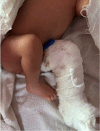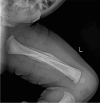Femur Fracture in a Newborn During Emergency Cesarean Delivery: A Case Report
- PMID: 39764274
- PMCID: PMC11702426
- DOI: 10.1002/ccr3.70084
Femur Fracture in a Newborn During Emergency Cesarean Delivery: A Case Report
Abstract
Birth injury occurs when the delivery process is not appropriately attended, and the use of improper techniques or maneuvers while conducting the delivery. Cesarean delivery is considered safe as compared to vaginal for the breech presentation. However, this case reports a case of femur fracture of a newborn that occurred during an emergency cesarean section performed for breech presentation. This highlights cesarean section for malpresentation is not completely safe.
Keywords: birth injury; breech presentation; cesarean section; femoral fractures; newborn.
© 2025 The Author(s). Clinical Case Reports published by John Wiley & Sons Ltd.
Conflict of interest statement
The authors declare no conflicts of interest.
Figures




Similar articles
-
Bilateral Humerus and Right Femur Fracture in a Newborn after Cesarean Section for Breech Presentation in a Twin Pregnancy: A Very Rare Case Report.J Orthop Case Rep. 2017 Jan-Feb;7(1):9-11. doi: 10.13107/jocr.2250-0685.664. J Orthop Case Rep. 2017. PMID: 28630830 Free PMC article.
-
Fracture of the Femur of A Newborn after Cesarean Section for Breech Presentation and Fibroid Uterus : A Case Report and Literature Review.J Orthop Case Rep. 2014 Jan-Mar;4(1):18-20. doi: 10.13107/jocr.2250-0685.141. J Orthop Case Rep. 2014. PMID: 27298938 Free PMC article.
-
Femoral fracture during breech vaginal delivery: A case report.J Gynecol Obstet Hum Reprod. 2022 Mar;51(3):102310. doi: 10.1016/j.jogoh.2022.102310. Epub 2022 Jan 5. J Gynecol Obstet Hum Reprod. 2022. PMID: 34998975
-
[Breech Presentation: CNGOF Guidelines for Clinical Practice - Benefits and Risks for the Neonate and Child of Planned Vaginal Delivery versus Elective Cesarean Section].Gynecol Obstet Fertil Senol. 2020 Jan;48(1):95-108. doi: 10.1016/j.gofs.2019.10.023. Epub 2019 Oct 31. Gynecol Obstet Fertil Senol. 2020. PMID: 31678508 Review. French.
-
Term breech presentation-Intended cesarean section versus intended vaginal delivery-A systematic review and meta-analysis.Acta Obstet Gynecol Scand. 2022 Jun;101(6):564-576. doi: 10.1111/aogs.14333. Acta Obstet Gynecol Scand. 2022. PMID: 35633052 Free PMC article.
References
-
- Kevin Emeka C., Uchenna E., Joseph Tochukwu E., Obinna Chukwuebuka N., Thaddeus Chikaodili E., and Chukwunonso C. I., “Profile of Birth Injuries in a Tertiary Hospital in Enugu, Nigeria,” American Journal of Biomedical and Life Sciences 7, no. 5 (2019): 99, 10.11648/j.ajbls.20190705.11. - DOI
LinkOut - more resources
Full Text Sources

